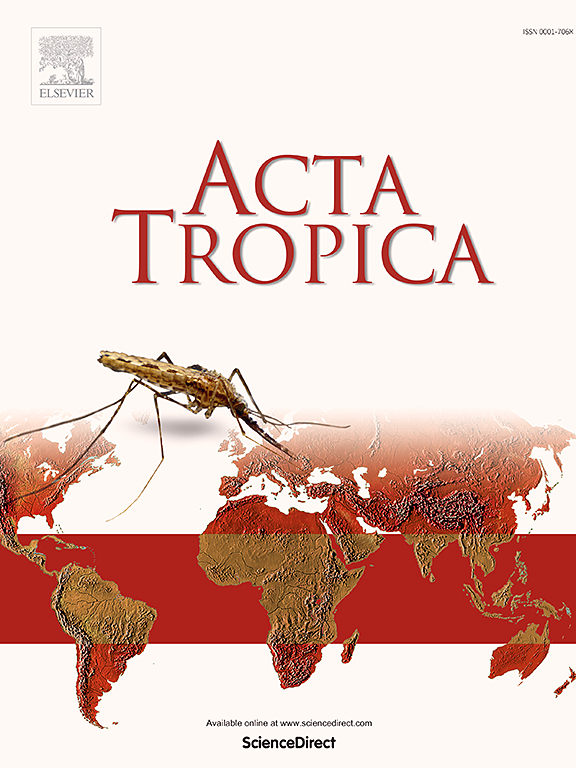Phylogeographic investigation of tick-borne pathogens in host-seeking Dermacentor marginatus in Anatolia: Significant correlation between population genetic structure and SFG rickettsiae
IF 2.1
3区 医学
Q2 PARASITOLOGY
引用次数: 0
Abstract
Characterizing the population structure of vector ticks and their associated microorganisms in natural foci is essential for understanding of the ecology of tick-borne disease (TBD) and developing effective control strategies. Dermacentor marginatus is an important vector species in the Palearctic realm, yet its vectorial role remains poorly defined, particularly due to the lack of studies integrating population genetics with pathogen data. In this study, we performed a phylogeographic analysis of tick-borne pathogens (TBPs) in host-seeking D. marginatus from natural foci across Anatolia, integrating these data with the population genetic information from the same specimens. A total of 696 ticks from 151 locations were screened. PCR and sequencing revealed that 58.8 % (409/696) of ticks carried at least one causative agent, including spotted fever group (SFG) rickettsiae (Rickettsia slovaca and R. raoultii), Coxiella burnetii, Francisella tularensis subsp. holarctica, Francisella-like endosymbionts, Babesia spp. (B. occultans, B. vulpes, and B. bigemina), Theileria ovis, and Hepatozoon spp. (H. canis and two unidentified species). Our findings revealed distinct phylogeographic patterns of SFG rickettsiae between Central and Northeastern populations, providing the first evidence of a population-level evolutionary association between D. marginatus and R. slovaca/raoultii. Previously unrecognized natural foci of C. burnetii and F. tularensis subsp. holarctica associated with D. marginatus were also identified. Several novel tick-pathogen associations were documented. These results indicate a high prevalence of human-pathogenic agents in D. marginatus populations in Anatolia suggest that population genetic structure may influence silent tick-pathogen interactions. By integrating population genetics with pathogen screening, this study offers new insights into the ecology and evolutionary dynamics of D. marginatus and associated TBPs.
安纳托利亚地区寻找寄主的边缘革螨蜱传病原体的系统地理学研究:种群遗传结构与SFG立克次体的显著相关性。
确定自然疫源地媒介蜱及其相关微生物的种群结构对了解蜱传疾病的生态学和制定有效的控制策略至关重要。边缘革螨是古北界重要的病媒物种,但其病媒作用仍不明确,特别是由于缺乏将种群遗传学与病原体数据结合起来的研究。在这项研究中,我们对来自安纳托利亚各地自然疫源地的寻找寄主的边缘蜱蜱传病原体(tps)进行了系统地理学分析,并将这些数据与来自相同标本的种群遗传信息相结合。共筛选了151个地点的696只蜱。PCR和测序结果显示,58.8%(409/696)的蜱携带至少一种病原体,包括斑点热组(SFG)立克次体(slovaca立克次体和raoultir)、伯氏柯谢氏体、土拉弗朗西菌亚种。holarctica, Francisella-like内共生体,巴贝斯虫(B. occultans, B. vulpes和B. bigemina),鹅氏肠杆菌和肝虫(H. canis和两个未知种)。研究结果揭示了SFG立克次体在中部和东北部种群间不同的系统地理分布模式,首次为边缘立克次体与slovaca/raoultii立克次体在种群水平上的进化关联提供了证据。以前未被认识的伯氏梭菌和土拉螺旋体亚种的自然疫源地。此外,还发现了与边际花有亲缘关系的全北极花。记录了几种新的蜱-病原体关联。这些结果表明,安纳托利亚地区边缘蜱种群中人类致病性病原体的高流行率表明种群遗传结构可能影响沉默蜱与病原体的相互作用。本研究将群体遗传学与病原菌筛选相结合,为边角田鼠及其相关tps的生态学和进化动力学提供了新的见解。
本文章由计算机程序翻译,如有差异,请以英文原文为准。
求助全文
约1分钟内获得全文
求助全文
来源期刊

Acta tropica
医学-寄生虫学
CiteScore
5.40
自引率
11.10%
发文量
383
审稿时长
37 days
期刊介绍:
Acta Tropica, is an international journal on infectious diseases that covers public health sciences and biomedical research with particular emphasis on topics relevant to human and animal health in the tropics and the subtropics.
 求助内容:
求助内容: 应助结果提醒方式:
应助结果提醒方式:


